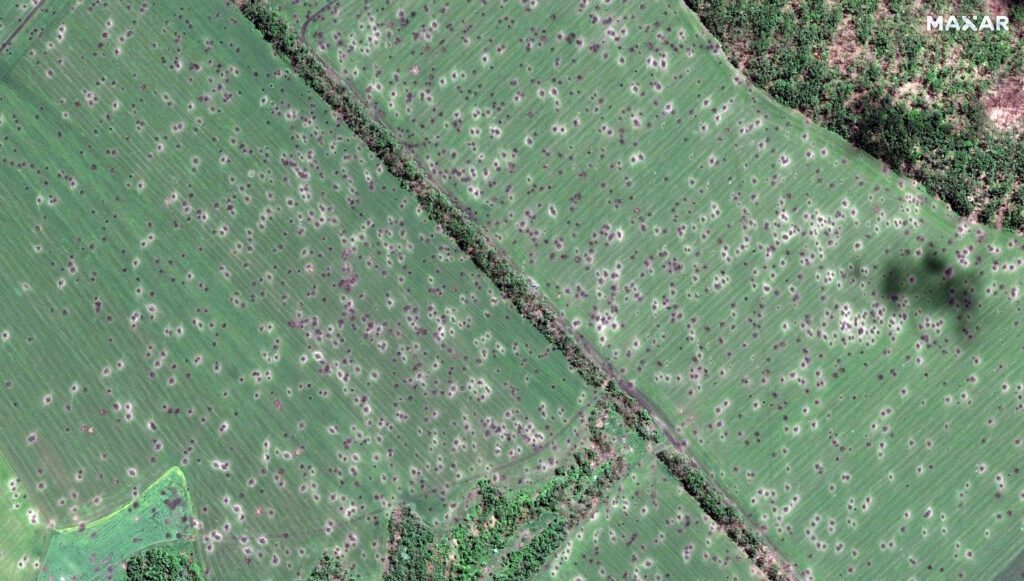Wars are never good for the economies. But wars waged by Russia — a country with no respect for international laws — are set out to completely destroy them. This is what’s happening in Ukraine right now.
Political, social, and economic growth of Ukraine triggered Russia’s authoritarian regime for years (if not decades). As Ukrainian social media users pointed out: just as Ukraine’s GDP was set to exceed $4000 per capita, Russia started or intensified wars.
Source: Statista
From stolen washing machines and precious antiquities to demolished infrastructure and bombed agrarian fields, Russia attempts to wipe out Ukraine’s economic progress to cease its existence.
Overview of Ukraine’s Economy Before Full-Scale Invasion
Ukraine is a developing country. Before the full-scale invasion, the three most important export sectors were agriculture, metallurgy, and information technology (IT). In 2020, 49% of exports were agricultural produce and 19.5% were metals. Ukraine is among the leaders in the exports of sunflower seed oil (5,27 million metric tons in 2020/21), wheat (24,2 million metric tons in 2021/22), and maize (33,5 million metric tons in 2021/2022).
Despite “the breadbasket of Europe” nickname, the Ukrainian economy still lags behind other former Soviet states. Domestic political issues, corruption, and negative cultural influences from Russia stalled our economic progress. For comparison, Ukraine’s GDP was $3,741 per capita in 2020, in Latvia, this KPI was $17,622.
Still, we made sizable progress over the years in terms of economic growth.
Ukraine’s Economic Challenges Throughout 30 Years Of Independence
Ukrainian economic growth has not always been stable, occasionally interrupted by global crises, domestic problems, and negative Russian influence, including its outbursts of aggression, the latest of which is happening right now.
Here’s what Ukraine has been through prior to 2022:
- Hyperinflation in the 1990s: Ukraine suffered from economic depression and hyperinflation of 4734,9% due to a lack of reforms, insufficient access to financial markets, and fear of introducing a fully-fledged national currency.
- Russian gas blackmail: Deliveries of gas became a primary political instrument Russia has been and is still using against Ukraine. Russia damaged Ukraine’s reputation among international audiences long before the war by spreading lies that Ukraine ‘was stealing’ gas. In courts they could not provide a single proof, however.
- 2008 financial crisis: The world economic recession put a damper on capital flows and investments in Ukraine, leading to a 3% increase in unemployment and a devaluation of the national currency.
- 2014 Russian invasion: Russian occupation of Crimea and a portion of the Donbas region caused economic perturbations. Ukraine lost access to its core mining infrastructure. The risks of war also postponed foreign investments. Ukraine had to cut ties with Russia, its biggest trading partner.
- Covid-19 pandemic: Lockdowns, costly vaccine imports, and rapid shifts to remote work had a strong impact on the speed of Ukraine’s economic recovery prior to 2020.
Here’s how Ukraine’s GDP per capita changed in response to all these events:
Source: The World Bank
Despite all declines and recessions, Ukrainians pushed the government to take measures that would improve economic well being. Ukraine’s 2014 revolution, for instance, was the result of the nation’s desire to be politically and economically integrated into the European Union, not the Eurasian Customs Union.
How Ukraine Dealt with Economic Challenges
The challenges mentioned above forced the country to undergo significant changes.
Ukraine continues to implement necessary market reforms, has distanced itself economically from Russian markets, reduced dependency on Russian energy sources, and created a more conducive environment for small and mid-sized businesses to prosper.
Here’s how Ukrainians act in the wake of economic uncertainties
- National currency establishment: Hryvnia’s introduction in 1996 helped stave off hyperinflation and stabilize the economy.
- Integration into the global economy: Ukraine has established exports of food, metal, chemicals, and services. The country joined organizations such as the International Monetary Fund and the World Trade Organization. The signing of the Association Treaty between the EU and Ukraine was another major milestone.
- Privatization: In 1992, the government began to transfer assets and land from the public sector to the private sector, thus stimulating the economy
- Anti-corruption reforms: Ukrainian law enforcement agencies and institutions like the National Anti-Corruption Bureau and the National Agency for Corruption Prevention were set up to battle corruption.
- Decentralization: By granting local authorities more power and monetary resources, the state fosters stronger regional economies.
- Public procurement transparency: Ukraine has developed Prozorro, a platform that aims to ensure open access to public procurements (tenders).
- Land reform: Landowners, farmers, communities, and all Ukrainians finally have the right to sell and buy land.
- Reduced bureaucracy: Diia – an e-government app – allows users to pay taxes, fines, and obtain other government services without physically going to an institution. The Diia can also be used to remotely distribute incentive payments and financial aid from the state to citizens. For instance, from regions most affected by the war received one-time payments after February 24 through Diia.
Ukrainian Economy After Russian Full-Scale Invasion
Before 2022, Ukraine’s economy was climbing up. By 2026, GDP was forecasted to reach $290 billion. Despite the ongoing war in the east of Ukraine, Ukrainians’ standards of living were also set to improve. The average minimum monthly wage increased by 306% between 2016 and 2021 – and was expected to keep an upward trend:
Source: Statista
Post-invasion, the prognosis is bleak. By the end of 2022, the Ukrainian economy will shrink by 45%. The longer and more destructive the war will become, the more economic losses we’ll carry.
Russian war crimes multiple with each day, as is Ukraine’s economic toll. Businesses are forced to close down or relocate elsewhere in Ukraine or abroad. Industrial complexes are destroyed beyond repair.
Current losses include:
- Refugees: Some 4.8 million refugees left Ukraine for Europe. That’s a major loss of talent, taxpayers, and local buyers, who could support the remaining businesses, pay taxes, or spend money in Ukraine which also causes economic losses.
- Infrastructure damage: As of May 25, Ukraine had lost $105.5 billion in infrastructure damages:
Source: Statista
- Mined fields: Russians have been mining farmer’s fields as they retreat. Agricultural lands are also damaged by constant shelling and bombardments. This will deteriorate soil health, endanger farmers, and harm future sowing campaigns on which global food supply and Ukraine’s economy largely depend. This is how fields near Kharkiv look right now:

Source: Maxar Technologies Twitter
- A blockade of ports: Ukraine cannot export goods, namely grain, through Black Sea ports due to the danger of naval mines and shelling by Russian ships. According to the UN, even if ports were opened immediately, demining would take months.
- Stolen Ukrainian goods: Russia steals grain, farming equipment, and metal from occupied territories of Ukraine and then attempts to sell them.
- A loss of business: Occupation forces businesses to close, reduce their operations, or relocate. Metallurgy, chemical, engineering, and agriculture are the industries most affected — those that were important to Ukraine’s export potential. Here are estimated direct losses to assets of enterprises in Ukraine:
Source: Statista
Ukraine is going through one of its worst economic periods. What’s different, however, is that we have the financial and moral support of a strong global community.
Restoring Ukraine’s Economic Health
Ukrainians are resilient folks: we are already doing proactive damage control. For example, the government reduced taxes so that businesses could power through the war. Regional authorities of non-occupied regions help businesses relocate from temporarily occupied territories. Volodymyr Zelensky announced a one-time 6500 hryvnias compensation to people from regions most impacted by war.
We also keep doing whatever it is that we are good at. The IT sector generated a record-breaking $2 billion income during the first quarter of 2022. Farmers in Ukraine have sown 75% of the lands they planted last year, despite dangers and challenges.
Yet, we know we are not alone.
We receive significant help from the global community as well. Below are the steps the world is taking to help Ukraine’s economy:
- Financial aid: In May, the European Union provided Ukraine with a new package of macro-financial assistance worth €600 million. The same month, The US Senate approved $40 billion in aid to Ukraine, signed by Joe Biden. Since the outbreak of the full-scale war, people from all over the world have transferred nearly 17.1 Billion hryvnias to a special account of the National Bank of Ukraine.
- New trade opportunities: The EU, Canada, and the UK recently removed customs duties and quotas for Ukrainian goods. The US abolished customs duties on Ukrainian steel. Volodymyr Zelensky states that Australia may follow an example, too.
- Export assistance: Ukraine has set up two new routes through Romania and Poland to export grain and avoid a worldwide food shortage. We also negotiate with Baltic states on a third route.
- Assistance with fuel: A “green corridor” for EU fuel trucks has been set up along the Ukraine border to avoid an ongoing fuel deficit in the country.
- Electricity market: EU helped Ukraine become part of the European electricity market. This way, Ukraine does not have to rely on the Belarus network. Also, Ukraine will be able to sell and purchase electricity to and from European countries.
Such help not only restarts the Ukrainian economy but also creates a sense of support for Ukrainians. It’s not only about the money and resources. It is about the action-proven belief that the Ukrainian economy — and Ukrainian nation — will power through the darker period and emerge stronger.
However, the more the war goes on, the more the global community loses interest in it. From the first week of the war to the most recent week, there has been a 22-fold decline in interactions on news articles about Ukraine.
Ukraine fears that these trends might indicate a gradual decline in global assistance while deaths and economic losses continue to rise.
Although Russia gave up the plan to hold Blitzkrieg, the war has not ended, nor has it become any less bloody. It instead becomes more prolonged. Moreover, the longer the war lasts, the bigger role the economy will play.
Ukraine will have a harder time protecting and winning the war if it receives less and less financial assistance, while Russia gets more and more payments for energy resources. And winning is crucial since the survival of all Ukrainians depends on it.
“Wherever Russia controls Ukrainian territory, Russians commit genocidal crimes against citizens of Ukraine, including mass rape, mass killing, and mass deportation. A democracy is defending itself against autocracy, and the fate of democracies hangs in the balance.”
Timothy Snyder
If Ukrainians and their economy do not endure prolonged war, then what Timothy Snyder wrote about will happen all over Ukraine.
Final Thoughts
Our economic strength aids our military might, which is essential for stability in the region.
By causing damage to our land and committing war crimes against our people, Russians have slowed down Ukraine’s economic growth. In spite of this, Ukraine is not experiencing a crisis of morale or lack of commitment. We still strategically win the battlefield. Our commitment to freedom compensates for the loss of financial resources.
However, in the long run, we will still need a powerful economy to fight for our existence and security in Europe.
Do you want to support Ukraine’s humanitarian, military, and economic capacities? Here are some ways to do it!

